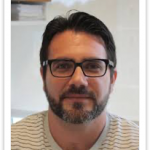ISMSM Faculty

Emanuela Del Gado, Director
Emanuela Del Gado is a theoretical physicist working on engineering-motivated problems. She uses statistical mechanics and computational physics to investigate materials with structural and dynamical complexity, from model amorphous solids, gels, and glasses, to new green formulations of cement.
Prof. Del Gado received her undergraduate degree (Laurea in Physics, cum laude) at the University of Naples “Federico II” in Italy, where she also obtained a Ph.D. in Physics in 2001. She has been a Marie Curie Fellow at the University of Montpellier II in France and a post-doctoral researcher at ETH Zurich in Switzerland and holds visiting positions at ESPCI (France) and MIT. Before joining Georgetown University, Emanuela was the Swiss National Science Foundation professor in the Department of Civil Environmental and Geomatic Engineering at ETH Zurich.
More information on Emanuela Del Gado’s research can be found on the Georgetown Physics Department Website.

Styliani Alimperti
The integration of medicine and technology within a single framework for potential translational and therapeutic purposes in diseases is the major goal in Alimperti lab. Specifically, research in her laboratory at Georgetown University is focused on identifying the factors controlling the development, maintenance, loss of function, and repair/regeneration of tissues by developing novel tissue engineering and regenerative strategies based on cellular engineering technology, materials science, molecular biology methods, micro-and nanofabrication, and additive manufacturing.

Daniel Blair
In the Blairlab we are investigating the structure and mechanical properties of soft and biological materials. These materials are often found in disordered and geometrically frustrated configurations that are far from thermal equilibrium. We are particularly interested in how these materials respond to bulk and localized stresses and strains. Using advanced microscopy techniques, such as laser scanning confocal microscopy, coupled with simultaneous rheological measurements, we investigate the interplay between the structure and the dynamics of these materials as they are driven in a shear flow. Insights gained from our experiments will provide insights into many different practical and fundamental materials.
See the Blair Lab Youtube site for some fun videos!
Visit Daniel Blair’s website for more information on his research.

David Egolf
The Egolf group performs computational and theoretical research focused on the dynamic and statistical properties of systems maintained far from equilibrium. Of particular interest are granular systems, excitable media such as cardiac and neural tissue, fluid systems, and biopolymer networks. The dynamics of these systems often appear hopelessly complicated to the eye, but, using techniques from nonlinear dynamics and statistical mechanics, we are able to untangle the dynamics and reveal underlying mechanisms that may eventually lead to predictive theories.
Visit David Egolf’s website for more information on his research.

Nagarjuna Gavvalapalli
The Gavvalappali group’s research program focuses on the rational design and development of functional organic polymers and nanostructures. The group’s core strength is the design, development, synthesis, and structural characterization of smart functional polymers and the self-assembly of organic molecules and nanostructures. Students are trained at the interfaces of organic chemistry, polymer chemistry, and nanoscience, and gain expertise in the design and synthesis of small molecules, polymers, and nano/colloidal particles.
Visit Najarjuna Gavvalapalli’s website for more information on his research.

Jong-In Hahm
The Hahm group develops block copolymer-assisted protein arrays, featuring high protein density and functionality, using various self-assembled nanodomains in ultrathin diblock copolymer thin films for spatially arranging precisely known numbers of protein molecules into 1D or 2D arrays. They study key interaction parameters governing the adsorption of proteins to chemically homogeneous and/or heterogeneous nanosurfaces and predict and control the bottom-up assembly of proteins and other biomolecules on polymeric surfaces.
Visit Jong-In Hahm’s website for more information on her research.

Miklos Kertesz
The Kertesz group is interested in the computational modeling of unusual intermolecular interactions. These studies involve for example secondary bonds as utilized in the design of molecular actuators, and pancake bonds as applied to new organic materials for electronic transport. Work on structures of organic materials helps understand preferred intermolecular packing arrangements at the atomic level that affect properties at larger length scales. An additional project helps elucidate intermolecular interactions that involve the encapsulation of one molecule by another.
Visit Miklos Kertesz’s website for more information on his research.

Rodrigo Maillard
Our lab is at the forefront of deciphering the molecular underpinnings of protein allostery, with profound implications for biomedical sciences. We explore a range of proteins crucial to cancer research, circadian rhythms, and gene regulation. By linking protein function with folding, stability, and conformational dynamics, we’re peeling back the layers of biology’s complexity. Our toolkit features genetic engineering, chemical labeling, spectroscopies, calorimetry, and single-molecule methods based on optical tweezers. Beyond basic science, our research paves the way for new therapeutic strategies focused on allosteric inhibitors with potent activity and high levels of selectivity.
More information on Rodrigo Maillard’s research can be found on https://maillardlab.org/.

Steven J. Metallo
Natively unstructured or intrinsically disordered (ID) proteins are common in eukaryotes. Proteins with ID regions are often associated with regulatory and signaling pathways in higher organisms and have been implicated in many diseases. These proteins do not have stable secondary or tertiary structures but neither do they exist as simple random-coil polymers. They sample a certain ensemble of conformations, rapidly converting between conformations. We have demonstrated multiple examples of how small molecules can bind with specificity to their counter-intuitive, unstructured targets. We are working to understand more generally the energetics of these interactions and the role that peptide dynamics plays in determining binding site selection and specificity in the realm of unstructured proteins.
More information on Steven Metallo’s research can be found on the Georgetown Chemistry Department website.

Peter Olmsted
Olmsted’s current research is mainly in theory and computer simulation and includes rheology, dynamics, and instabilities in soft matter, polymers, lipid membranes, and proteins. Common threads in his work are phase transitions, non-equilibrium phenomena, and fluctuations. He works closely with experimentalists, and often on industrially-motivated problems.
More information on Peter Olmsted’s research can be found on the Georgetown Physics Department Website.

Jennifer Swift
The Swift lab is broadly interested in molecular crystals – their nucleation, growth, physical properties, and potential to undergo solid state phase transformations. This research area has many direct applications to the medical, pharmaceutical, defense, and food-product industries. Ongoing projects focus on structure-property relationships in hydrates and polymorphs, biomineralization pathways of components associated with diseases such as gout and kidney stone formation, and nitrogen excretion in uricotelic species.
Visit Jen Swift’s website (http://swift-lab.org/) for more information on her research.

Jeffrey Toretsky
Jeffrey Toretsky, M.D. is a pediatric oncologist who investigates the mechanisms of cancer while identifying novel therapeutic targets. The Toretsky laboratory focused on developing a therapeutic molecule for Ewing sarcoma since these tumors contain a unique target, EWS-FLI1, which is not found in non-tumor cells. The first small molecule to directly target EWS-FLI1, YK-4-279, is a useful laboratory probe and an analog is advancing to clinical trials. In a more granular exploration of the fusion protein EWS-FLI1 and the action of YK-4-279, Dr. Toretsky found himself in the world of intrinsically disordered proteins. He identified EWS-FLI1 as a major regulator of alternative mRNA splicing and hypothesizes that splicing occurs in a phase-separated nuclear body called the nuclear speckle. He leads a team that is now undertaking projects elucidating oncogenic mechanisms occurring through phase separation of nuclear bodies, including alternative splicing and chromatin access by transcription factors. Active collaborations in the I(SM)2 include professors Blair, Metallo, Olmsted, and Del Gado.
Visit Jeffrey Toretsky’s website for more information on his research.

Jeff Urbach
Researchers in Urbach Lab are investigating complex dynamics in a variety of systems, ranging from complex suspensions to biopolymer networks to migrating neurons. Using the techniques of statistical physics and nonlinear dynamics, together with advanced imaging techniques, image processing, and computer simulations, they are trying to develop quantitative, testable descriptions of multifaceted, interacting, ever-changing systems that might at first glance seem like a complicated mess.
More information on Jeff Urbach’s research can be found on the Georgetown Physics Department website.

Edward Van Keuren
Work in the Van Keuren lab is focused on the study of the nucleation and growth of nanoparticles in solution. They use precipitation methods to induce a high level of supersaturation in a solution and observe the formation of nanoparticles using a number of methods, including dynamic light scattering, absorption, fluorescence, and Raman spectroscopy and electron microscopy. These observations are used to develop and refine models of molecular aggregation/self-assembly.
For more information about Edward Van Keuren’s research, please visit his website.

Richard G. Weiss
The Weiss group studies mechanistic photochemistry and photophysics, mechanisms of reactions, and nuclear magnetic resonance in aligning media, gels, ionic liquids, polymers, and liquid crystals. The photochemical and photophysical studies are frequently conducted in the soft matter matrices, many of which have been developed within the Weiss lab. In addition, some of the materials are being examined as reversible adhesives, food additives, for art conservation and dispersants and coagulants to contain oil spills.
For more information about Richard Weiss’ research, please visit his website.

Xinran Zhang, Assistant Director
Responsible for the administration and management of the core instrumentation facility.
For more information about Xinran Zhang’s research, please visit the Georgetown Physics Department Website.
